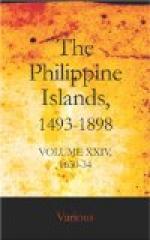[74] For sketches of these friars, see Perez’s Catalogo.
[75] Fray Nicolas de Herrera was a missionary in Sesmoan (1618), Lubao (1623 and 1626), and Bacolor (1632). He was definitor in 1629, prior of Manila in 1635, and president of the provincial chapter in 1638, dying in 1647. See Perez’s Catalogo, p. 89.
[76] Fray Martin de Errasti was a native of Vizcaya, and professed in the convent of Burgos. After going to the Philippines, he became missionary in Porac, Apalit, and Bacolor (1635). He acted as definitor and prior of Manila. He was elected provincial in 1638, but died in 1639. See Perez’s Catalogo, p. 93.
[77] Cristobal de Miranda was a missionary in the villages of Mexico in 1614, and of Apalit, Betis, Sesmoan, Guagua, Minalin, Candaba, Macabebe, and Bacolor until 1641. He was definitor in 1632 and died in 1646. See Perez’s Catalogo, p. 88.
[78] Fray Lorenzo (not Alonso) Figueroa labored in the villages of Caruyan, Paranaque (1620), Santa Cruz (1626), and Agoo (1626). He was elected prior of the convent of Santo Nino de Cebu in 1629, after which he was sent to the villages of Lipa, Bigaa, Malate, Sala, Malalos, and San Pablo de los Montes (1653). His death is not recorded. See Perez’s Catalogo, p. 96.
[79] Doubtless masses for the deaths of Father Pedro Garcia and Father Cabrera.
[80] Fray Pedro de la Pena was born in Burgos, and professed in the convent of Badaya in 1599. He worked in the Ilocan villages of Bantay, and Narvacan (1617). After laboring also in the villages of Apalit and Macabebe (1626), he was chosen commissary-procurator to Madrid (1630), dying in the following year, aboard ship. See Perez’s Catalogo, p. 86.
[81] St. Luke, i, 37.—Coco.
[82] Fray Pedro de Quesada, a native of Jaen, took his vows in the province of Castilla. He was appointed preacher-general and reader of theology in 1630, and labored afterward in the villages of Malolos (1632), Lipa (1636), and Bulacan (1638). In 1639 he went to Spain as procurator-commissary of Madrid and definitor-general; but the intermediary chapter having annulled his appointment, he set out again for the islands as president of a mission of religious, dying in Mexico in 1645. See Perez’s Catalogo, p. 107.
[83] Paul’s Epistle to the Romans, viii, 37.—Coco.
[84] Paul’s Epistle to the Galatians, vi, 14.—Coco.
[85] Blumentritt in his List of Native Tribes of the Philippines (Mason’s translation, Washington, 1901), says of the people of this name: “In a chart of the Philippines for 1744, by P. Murillo Velarde, S. J., this name is to be seen west of Caraga and Bislig (Mindanao). English authors speak of the Tagaboloyes, Waitz mentions their clear color, and Mas calls them Igorrotes. Others add that they were Mestizos of Indians, and more fables to the same effect. Their region has been well explored, but only Manabos and Mandayas have been found there. The last named are clear colored, so Tagaboloyes seems to be another name for Mandayas. The name sounds temptingly like Tagabalies.”




